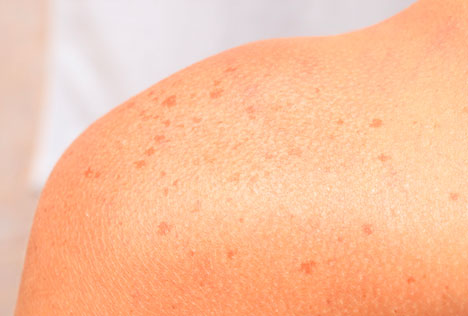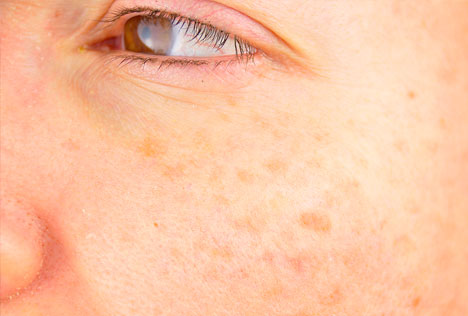Sun Spots
 Sunspots, also known as solar lentigines, are mainly caused by sun exposure.
Sunspots, also known as solar lentigines, are mainly caused by sun exposure.
Sun Damage Shows
Lentigines are those flat brown or tan spots that appear on the backs of your hands, on your face, arms, and shoulders, the areas that get the most ultraviolet ray exposure over the years. And while people over the age of 50 commonly develop the spots, younger adults who spend a lot of time outside without UV protection often begin to show them earlier.Sunspots can be mistaken for cancerous melanomas, so you should have them checked out by a New York City dermatologist if you have concerns. True sunspots, however, are harmless. The only damage sunspots make to your appearance.
How You Can Tell
Mostly, you see sunspots when you have fair skin, but they’re no strangers to darker-skinned people. Typically, they can range in size from the size of a freckle to as big as one-half inch in diameter. Additionally, sunspots tend to show up in groups, which makes them even more noticeable and unsightly. Other characteristics of sunspots include:- They show up in those areas that have gotten a lot of exposure to the sun.
- The color of sunspots tends to run from light tan to medium brown.
- Usually, they’re flat, not raised. They’re just darker pigmented skin.
- They are sharply defined.
Where Sun Spots Come From
 Dermatology researchers have learned that sunspots happen when sun exposure leads to excess melanin deposition in the top layer of your skin. Melanin darkens as it’s exposed to the harmful ultraviolet rays of the sun. All over, you get a tan when you spend time unprotected in the sun. But most often, certain spots on your skin get more exposure, and the color tends to clump together, creating sunspots. Not wearing sufficient sunscreen encourages the spots to grow. You’re also at a higher risk of getting them if you have lighter skin or have a history of getting sunburned. Extensive time outside unprotected or time spent in tanning booths increase your chances of getting sun spots too.
Dermatology researchers have learned that sunspots happen when sun exposure leads to excess melanin deposition in the top layer of your skin. Melanin darkens as it’s exposed to the harmful ultraviolet rays of the sun. All over, you get a tan when you spend time unprotected in the sun. But most often, certain spots on your skin get more exposure, and the color tends to clump together, creating sunspots. Not wearing sufficient sunscreen encourages the spots to grow. You’re also at a higher risk of getting them if you have lighter skin or have a history of getting sunburned. Extensive time outside unprotected or time spent in tanning booths increase your chances of getting sun spots too.
Diagnosis
An experienced Manhattan dermatologist sees sunspots almost every day. Such doctors usually can tell just by looking at them if yours are indeed sunspots. When in doubt, however, your dermatologist may take a small sample of the skin and send it to a lab for confirmation. To take the sample in the office, your dermatology doctor first numbs the area and then shaves off a tiny sample. It takes less than a minute, and you won’t need more than a Band-Aid when you leave. Spots that look a lot like sunspots also are easily recognizable to your dermatologist. In fact, you may have one of the conditions that closely resemble the brown sunspots:- Seborrheic Keratoses: These are very close in color to sunspots, but they look more like warts. They also have a waxy feel and seem to be pasted on your skin rather than part of it, whereas sunspots don’t feel any different from the rest of your skin.
- Moles: Sometimes, moles are flat, like sunspots, and often mistaken for solar lentigines.
- Melanoma: A certain kind of skin cancer called lentigo maligna melanoma can be similar in size and shape to sunspots. However, it has a more jagged edge and changes shape and color over time.
Treating the Spots
It’s good news when your dermatologist tells you that you don’t have skin cancer, just sunspots. It’s bad news, though, when your insurance company refuses to pay to have them removed. Since it’s primarily a cosmetic procedure, you’ll most likely be on your own for any treatment you choose to reduce the appearance of aging on your body. Your dermatologist offers some of these most common procedures to eliminate your sunspots:- Intense pulsed light: You’ll have few, if any, side effects from a laser treatment, although you’ll most likely need several sessions to rid yourself of the unsightly spots.
- Bleaching creams: As prescribed by your NYC dermatologist, these topical creams are stronger than those you can get over-the-counter in the drugstore.
- Chemical peel: This is another way to reduce the appearance of sunspots by removing the top layer of melanin pigmented skin.
- Cryotherapy: The process of freezing specific areas of your skin with liquid nitrogen effectively encourages your sunspots to fall off. While effective, this procedure can leave scars.
Prevention Rules
While you’re still young, stay out of the sun to prevent sunspots. Wear at least SPF 30 sunscreen, as well as protective clothing. And once you do develop sun spots and go through any kind of treatment, it’s even more important that you follow the directions of your dermatologist and protect your skin. All symptoms and skin findings should always be evaluated with a thorough consultation and physical examination for an accurate diagnosis and treatment plan in order to exclude any underlying serious condition. You should have any skin discoloration evaluated by your NYC dermatologist. But absolutely make an appointment if you have any doubts or if the spots:- Present an unusual combination of colors
- Are irregular or jagged around the edges
- Are very dark or change over time
- Start growing in size
- Become itchy or red
- Get tender
- Start to bleed
(212) 427-8750 Manhattan Dermatology (Midtown) 56 W 45th St, Ste 819, NY 10036
(212) 889-2402 Manhattan Dermatology (Union Square) 55 W 17th St, Ste 103, NY 10011
(212) 378-9984

